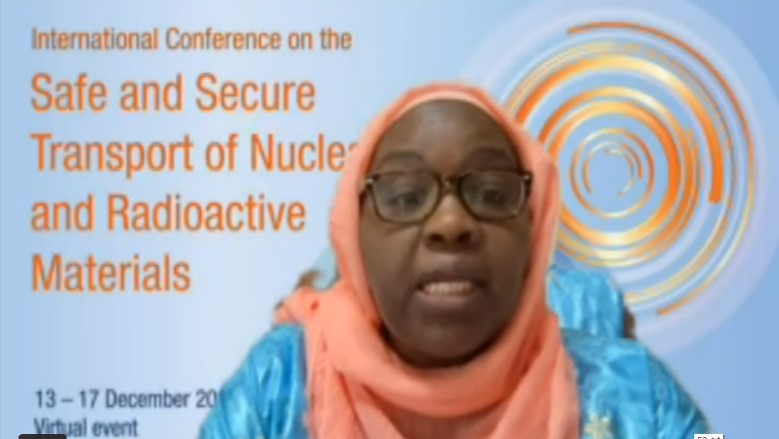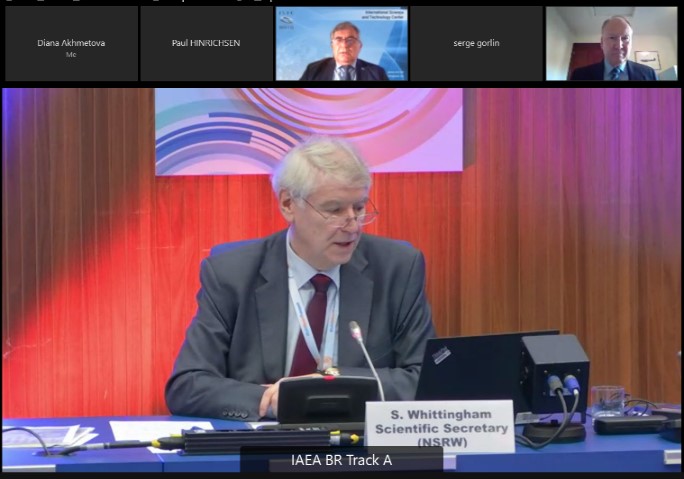ISTC takes part in the IAEA International Conference on the Safe and Secure Transport of Nuclear and Radioactive Materials (13–17 December 2021, Vienna)

In the week of 13 to 17 December 2021, the IAEA organized the International Conference on the Safe and Secure Transport of Radioactive Materials, designed to evaluate the prevailing conditions of the transport of nuclear and radioactive materials. More than 20 million shipments of such material occur globally per year, and a periodic survey of the situation is urgently needed to ensure proper governance of the transport systems, and to improve the regulatory framework and infrastructure for both safety and security.
This year, because of the Covid-19 pandemic, the conference had to be carried out as a virtual event. But that allowed over 600 participants to attend, more than twice the number at the previous conference on the subject, held ten years ago. The audience comprised officials, policymakers and operational stakeholders responsible for transport safety and security, including technical support organizations, law enforcement and border control agencies. Representatives from industry and civil society, including from non-governmental organizations and academic institutions, also took part in the conference.
 In his opening remarks IAEA Director General Rafael Mariano Grossi recalled that when nuclear and radioactive materials are on the move they are most vulnerable and urged the participants to remain vigilant as the number of theft incidents occurring during transport account for almost half of the total number of radioactive material theft incidents. The Conference Co-President Ndeye Arame Faye, Head of the Autorite de Radioprotection et de Surete Nucleaire, Senegal, echoed that appeal, and called for greater and more impactful international cooperation, particularly in Africa.
In his opening remarks IAEA Director General Rafael Mariano Grossi recalled that when nuclear and radioactive materials are on the move they are most vulnerable and urged the participants to remain vigilant as the number of theft incidents occurring during transport account for almost half of the total number of radioactive material theft incidents. The Conference Co-President Ndeye Arame Faye, Head of the Autorite de Radioprotection et de Surete Nucleaire, Senegal, echoed that appeal, and called for greater and more impactful international cooperation, particularly in Africa.
The program covered six main themes: the international framework for transport safety and security, national regulatory frameworks, industry perspectives, sustainability of the safety and security regime, emerging technologies, and international cooperation and regional approaches. Three side events were organized during the conference: “Nuclear Transport Security – Opportunities for Strengthening the Global Regime” by Nuclear Transport Solutions (UK); “The Successful Outcomes of using Virtual Platforms for Regional Cooperation of Transportation Security” by the National Nuclear Security Administration (US); and “Regional Cooperation on Transport Safety and Security in Southern Africa” by ISTC.
The ISTC side event on 16 December began with welcoming remarks by Stephen Whittingham, Conference Scientific Secretary, Unit Head of Transport Safety at the IAEA, who reminded the sixty plus attendees that transport safety and security is very much a team effort, at the international level.
ISTC Executive Director David Cleave noted that the presentations at the event were based on the findings and achievements from the EU-funded project Support to the Southern African States in Nuclear Safety and Safeguards, implemented by ISTC. The content of the side event illustrated major aspects of ISTC mandate, namely to support technological innovations, and their practical application, and to connect researchers and  practitioners across state boundaries and even continents.
practitioners across state boundaries and even continents.
Paul Hinrichsen, Principal Radiation Protection Specialist at the National Nuclear Regulator, South Africa, made a presentation on the AFCONE-FNRBA-ISTC Training Course on the Implementation of the IAEA Regulations for the Safe Transport of Radioactive Material, carried out in September 2021 by an international team of lecturers coming from Germany, Morocco and the RSA. The training course for 31 participants from 15 African countries was a tripartite endeavor of AFCONE, FNRBA and ISTC, and illustrated the Center’s support for the cornerstones of the African nuclear governance architecture.
Nikolay Palov, Director, Software Company, presented the Information Tracking System, developed by the IT company to monitor transport operations in eight SADC member states, where the system was installed and is currently in use. To ensure sustainability of the innovative IT tool, Software Company trained 184 experts from regulators and the industry form eight Southern African countries. A couple of weeks before the conference a real time exercise took place on tracking RAM transport from the Democratic Republic of Congo, through Zambia to Zimbabwe.
Dr. Boster Dearson Siwila, Executive Director, Radiation Protection Authority, Zambia and his counterpart from Zimbabwe, Justice Chipuru, Chief Executive Officer of the Radiation Protection Authority, took the floor to express the views of the competent authorities in project participating states invested with powers to issue authorizations and perform compliance monitoring. They appreciated the European assistance provided through ISTC for the development of competencies and capacities of the regulators to achieve the sustained delivery of effective regulatory oversight on transport. Moreover, they pointed out that technological tools such as the Information Tracking System not only facilitate the interaction among the Southern African neighbors – they make information exchange and synchronization of norms and policies a compelling necessity.
National and regional needs from the regulator and operator viewpoints featured at the side event. Speaking on behalf of the operators, Serge Gorlin, Head of Industry Cooperation at the World Nuclear Association presented the idea of a National Focal Point Network to improve transport reliability. Serge acts as co-Chair of the Transport Facilitation Working Group (TFWG), a multi-stakeholder initiative to preserve and open up new routes for the transport of radioactive material.
Apart from the side event, ISTC was also present at various other meetings of the international conference. For example, during session 2.5: Member States’ Regulations and Experience, Simon Adu from the Nuclear Regulatory Authority of Ghana presented a paper entitled Transport Security of Yellowcake at Southern African States, which he co-authored with ISTC SPM & DA Kamen Velichkov.
The record of the side event can be found at: http://streaming.iaea.org/21779

